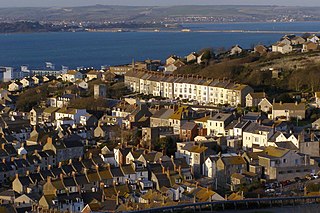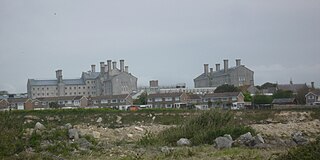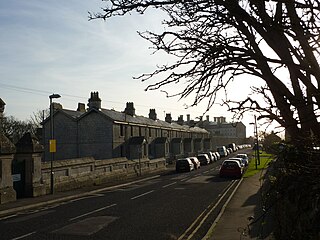
The Mulberry harbours were two temporary portable harbours developed by the British Admiralty and War Office during the Second World War to facilitate the rapid offloading of cargo onto beaches during the Allied invasion of Normandy in June 1944. They were designed in 1942 then built in under a year in great secrecy; within hours of the Allies creating beachheads after D-Day, sections of the two prefabricated harbours were towed across the English Channel from southern England and placed in position off Omaha Beach and Gold Beach, along with old ships to be sunk as breakwaters.

Portland Harbour is beside the Isle of Portland, Dorset, on the south coast of England. Construction of the harbour began in 1849; when completed in 1872, its 520-hectare (1,300-acre) surface area made it the largest human-made harbour in the world, and it remains one of the largest in the world today. It is naturally sheltered by Portland to the south, Chesil Beach to the west and mainland Dorset to the north. It consists of four breakwaters: two southern and two northern. These have a total length of 4.57 km (2.84 mi) and enclose approximately 1,000 ha of water.

Arromanches-les-Bains is a commune in the Calvados department in the Normandy region of north-western France.

Fortuneswell is a village in Underhill on the Isle of Portland, in Dorset, England. It lies on steeply sloping land on the northern edge of the island, known as Underhill, where Chesil Beach connects the island to the mainland. Adjoining Fortuneswell are Chiswell to the west and Castletown to the north. Fortuneswell occupies the steeper land above sea level, whereas Chiswell and Castletown occupy flat land close to sea level, next to Chesil Beach and Portland Harbour respectively. Fortuneswell has a main shopping street, and along with Easton, is the main hub of the island's activities.

Amphibious warfare is a type of offensive military operation that today uses naval ships to project ground and air power onto a hostile or potentially hostile shore at a designated landing beach. Through history the operations were conducted using ship's boats as the primary method of delivering troops to shore. Since the Gallipoli Campaign, specialised watercraft were increasingly designed for landing troops, material and vehicles, including by landing craft and for insertion of commandos, by fast patrol boats, zodiacs and from mini-submersibles. The term amphibious first emerged in the United Kingdom and the United States during the 1930s with introduction of vehicles such as Vickers-Carden-Loyd Light Amphibious Tank or the Landing Vehicle Tracked.

The Phoenix breakwaters were a set of reinforced concrete caissons built as part of the artificial Mulberry harbours that were assembled as part of the preparations for the Normandy landings during World War II. A total of 213 were built, with 212 floated or side-launched. They were constructed by civil engineering contractors around the coast of Britain. They were collected at Dungeness and Selsey, and then towed by tugboats across the English Channel and sunk to form the Mulberry harbour breakwaters replacing the initial "Gooseberry" block ships. Caissons were added in the autumn of 1944 to reinforce the existing structure to cope with the harbour continuing in use longer than planned.

A mole is a massive structure, usually of stone, used as a pier, breakwater, or a causeway separating two bodies of water. A mole may have a wooden structure built on top of it that resembles a wooden pier. The defining feature of a mole, however, is that water cannot freely flow underneath it, unlike a true pier. The oldest known mole is at Wadi al-Jarf, an ancient Egyptian harbor complex on the Red Sea, constructed ca. 2500 BCE.

Castletown is a small village in Underhill on the Isle of Portland in Dorset. It is located close to Fortuneswell, on the shores of Portland Harbour, and includes a sandy beach, as well as one of Portland's notable highlights; Portland Castle, while the Weymouth and Portland National Sailing Academy is also located nearby.
Bincleaves Groyne is a breakwater located off the southern area of Weymouth, England. It is the second largest of four breakwaters which create Portland Harbour. It is separated from the Northeastern Breakwater by the North Ship Channel. A landing stage is situated on the southern side of the breakwater near the Western Ledges.

Operation Overlord was the codename for the Battle of Normandy, the Allied operation that launched the successful liberation of German-occupied Western Europe during World War II. The operation was launched on 6 June 1944 (D-Day) with the Normandy landings. A 1,200-plane airborne assault preceded an amphibious assault involving more than 5,000 vessels. Nearly 160,000 troops crossed the English Channel on 6 June, and more than two million Allied troops were in France by the end of August.

PS Ryde is a paddle steamer that was commissioned and run by Southern Railway as a passenger ferry between mainland England and the Isle of Wight from 1937 to 1969, with an interlude during the Second World War where she served as a minesweeper and then an anti-aircraft ship, seeing action at D-Day. After many years abandoned on moorings at Island Harbour Marina on the River Medina, she was purchased by the PS Ryde Trust in late 2018, with the intention of raising money for her restoration. That project was abandoned in January 2019.

HM Prison Portland is a male Adult/Young Offenders Institution in the village of The Grove on the Isle of Portland, in Dorset, England. It is operated by His Majesty's Prison Service. The prison was originally opened in 1848 as an adult convict establishment, before becoming a Borstal in 1921, and a YOI in 1988. In 2011 it became an Adult/Young Offenders establishment.

The Grove is a small village located at Tophill on the Isle of Portland in Dorset. The village is found close to the larger village Easton, and is most notable for containing the HM Prison Portland, including its museum Grove Prison Museum. As with the rest of Portland's villages and settlements, The Grove has been designated as a conservation area, as it is a place of special architectural and historic interest. The village was designated in 1981.

Blacknor Fort is a 20th-century fort on the Isle of Portland, Dorset, England. It is located at Blacknor Point on the western side of Portland, close to Weston village.

Victoria Gardens is a public garden, located at Underhill, Isle of Portland, Dorset, England. It is found close to Fortuneswell village and overlooks both Victoria Square and Chiswell. The gardens, which were created to mark the 1897 Diamond Jubilee of Queen Victoria, have remained a focal point since their opening in 1904.

Folly Pier Waterworks was a 19th-century waterworks on the Isle of Portland, Dorset, England. It was located at East Weares, the east side of Portland, below HM Prison Portland, which it supplied water for. Today, only the foundations and walls of the reservoirs survive. The waterworks was named after Folly Pier, a pier once used for the transporting of Portland stone by sea.

St. John's Church is an Anglican Church of England church in Fortuneswell, on the Isle of Portland, Dorset. It was built between 1838–40 and has been a Listed Grade II building since January 1951. The churchyard walls, gate piers, railings, and steps of St. John's Church, dating from 1839–40, became Grade II Listed in September 1978. At this same time, two headstone monuments, about 5 metres north east from the west tower of the church became Grade II Listed.

Inner Pierhead Fort is a 19th-century fort built to defend Portland Harbour at the Isle of Portland, Dorset, England. It is positioned on the end of the inner breakwater, which abuts from the former dockyard of HMNB Portland. The fort was constructed between 1859-1862, and is 100 ft in diameter. The inner breakwater, including the fort, became Grade II Listed in 1978.

British logistics played a key role in the success of Operation Overlord, the Allied invasion of France in June 1944. The objective of the campaign was to secure a lodgement on the mainland of Europe for further operations. The Allies had to land sufficient forces to overcome the initial opposition and build them up faster than the Germans could respond. Planning for this operation had begun in 1942. The Anglo-Canadian force, the 21st Army Group, consisted of the British Second Army and Canadian First Army. Between them, they had six armoured divisions, ten infantry divisions, two airborne divisions, nine independent armoured brigades and two commando brigades. Logistical units included six supply unit headquarters, 25 Base Supply Depots (BSDs), 83 Detail Issue Depots (DIDs), 25 field bakeries, 14 field butcheries and 18 port detachments. The army group was supported over the beaches and through the Mulberry artificial port specially constructed for the purpose.
There are many Grade II listed buildings in the county of Dorset. This is a list of them.



















